Journal of Southern Medical University ›› 2025, Vol. 45 ›› Issue (9): 1946-1958.doi: 10.12122/j.issn.1673-4254.2025.09.14
Qi YUN1,2( ), Ruoli DU3,4, Yuying HE1,2, Yixin ZHANG5, Jiahui WANG3,4, Hongwei YE3,4, Zhenghong LI1,2, Qin GAO3,4(
), Ruoli DU3,4, Yuying HE1,2, Yixin ZHANG5, Jiahui WANG3,4, Hongwei YE3,4, Zhenghong LI1,2, Qin GAO3,4( )
)
Received:2025-02-13
Online:2025-09-20
Published:2025-09-28
Contact:
Qin GAO
E-mail:yunqiyq1009@163.com;bbmcgq@126.com
Qi YUN, Ruoli DU, Yuying HE, Yixin ZHANG, Jiahui WANG, Hongwei YE, Zhenghong LI, Qin GAO. Cinnamic acid ameliorates doxorubicin-induced myocardial injury in mice by attenuating cardiomyocyte ferroptosis via inhibiting TLR4[J]. Journal of Southern Medical University, 2025, 45(9): 1946-1958.
Add to citation manager EndNote|Ris|BibTeX
URL: https://www.j-smu.com/EN/10.12122/j.issn.1673-4254.2025.09.14
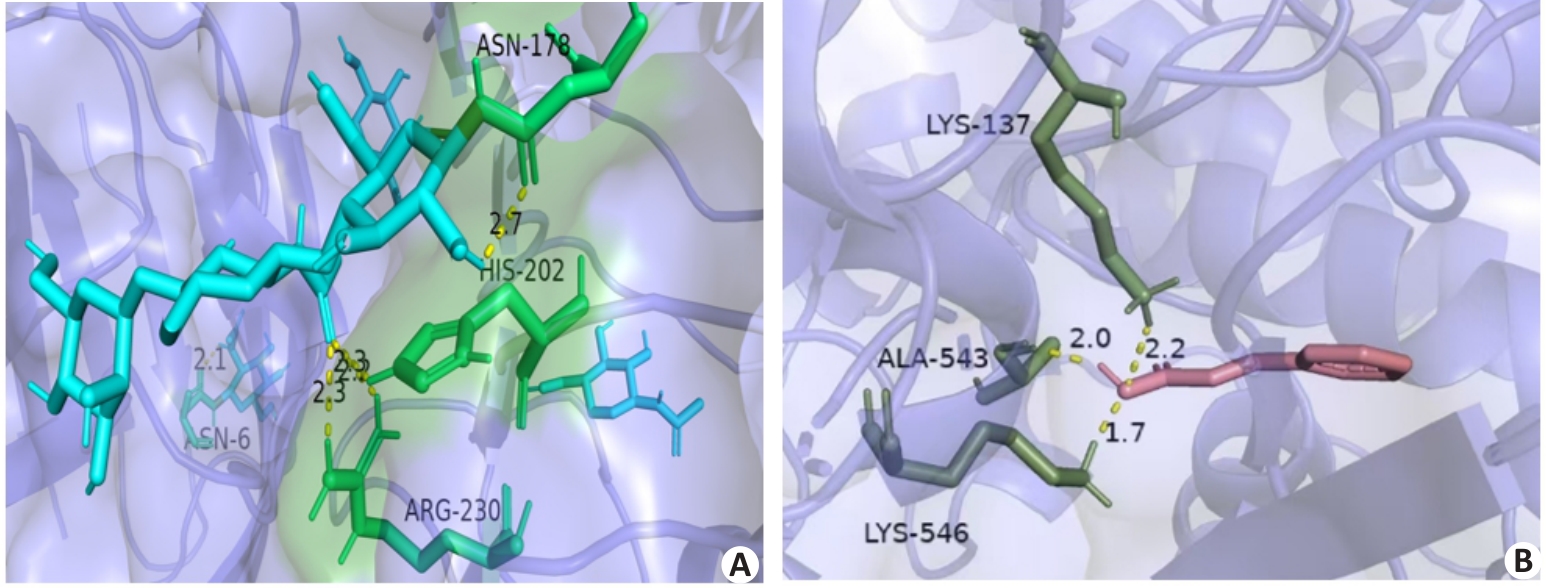
Fig.4 Visualization of molecular docking results. A: Potential interaction between CA and TLR4. B: Potential interaction between cinnamic acid and PTGS2.
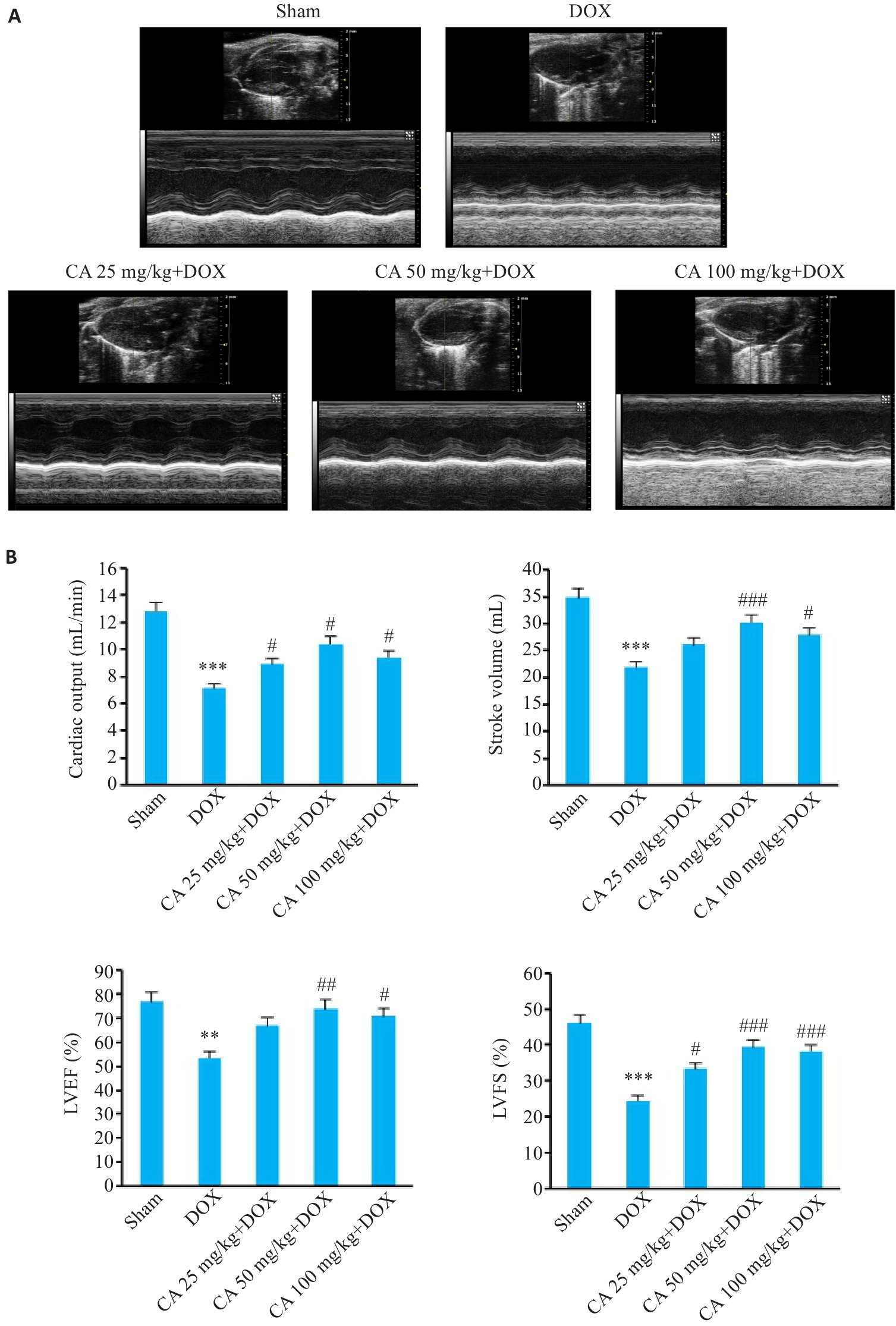
Fig.5 Cardiac ultrasound images and cardiac function indexes of the mice in different groups (Mean±SD, n=6). A: Evaluation of cardiac function by M-mode echocardiography. B: Comparison of echocardiographic parameters. LVEF: Left ventricle ejection fraction; LVFS: Left ventricular fractional shortening. **P<0.01, ***P<0.001 vs the Sham group; #P<0.05, ##P<0.01, ###P<0.001 vs the DOX group.
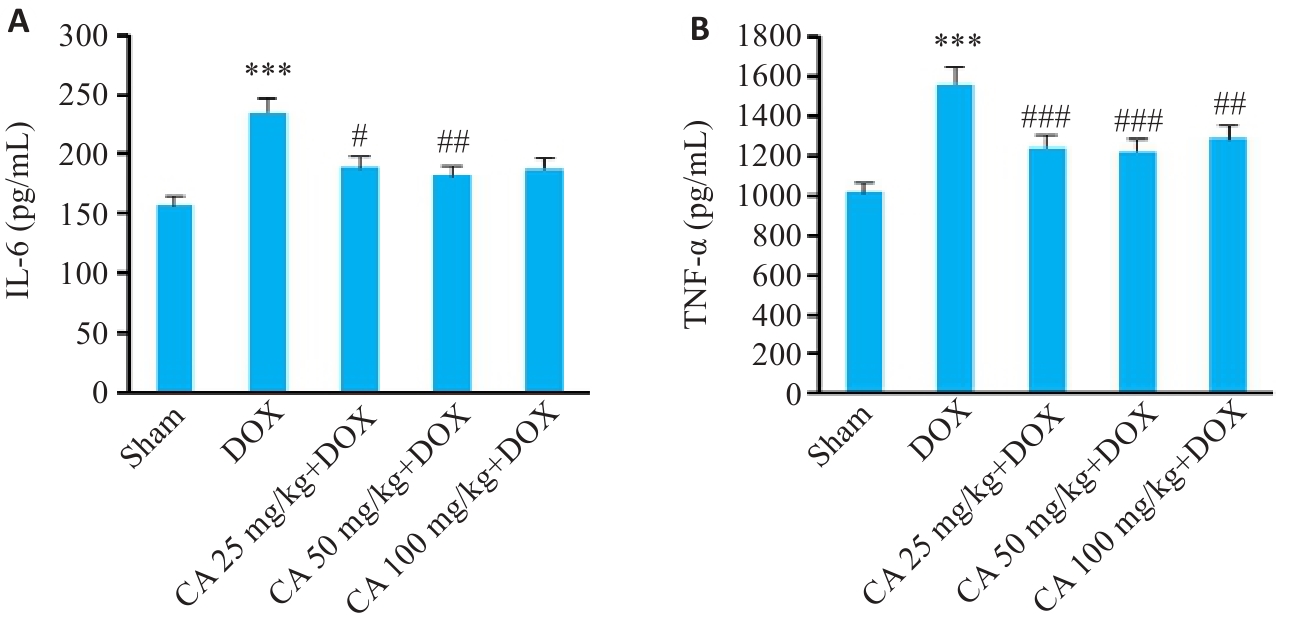
Fig.8 Serum IL-6 (A) and TNF-α (B) levels in different groups (Mean±SD, n=6). ***P<0.001 vs the Sham group; #P<0.05, ##P<0.01, ###P<0.001 vs the DOX group.
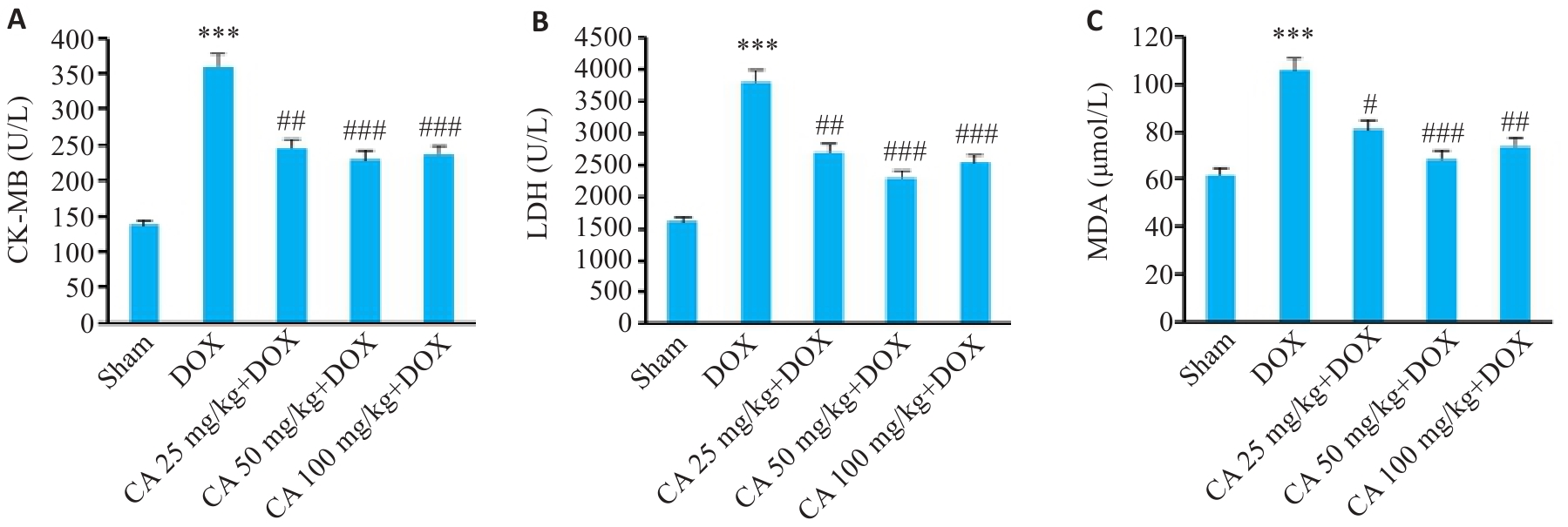
Fig.9 Serum CK-MB (A), LDH (B) and MDA (C) levels in different groups (Mean±SD, n=6). ***P<0.001 vs the Sham group; #P<0.05, ##P<0.01, ###P<0.001 vs the DOX group.
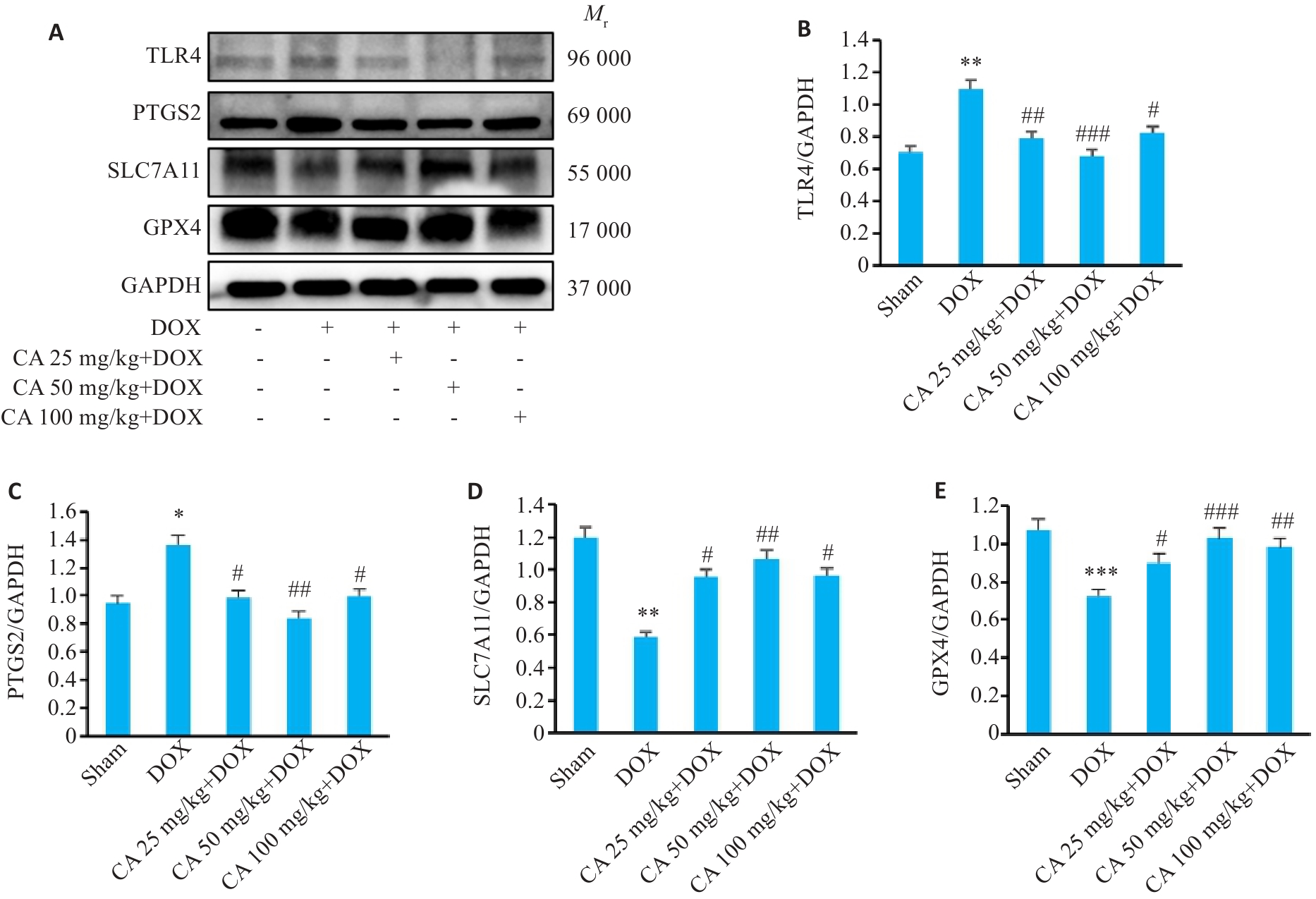
Fig.10 TLR4, PTGS2, SLC7A11 and GPX4 protein expressions in the myocardial tissues in the 5 groups. A: Protein bands in Western blotting. B-E: Relative protein levels of TLR4, PTGS2, SLC7A11 and GPX4 proteins (Mean±SD, n=3). *P<0.05, **P<0.01, ***P<0.001 vs the Sham group; #P<0.05, ##P<0.01, ###P<0.001 vs the DOX group.
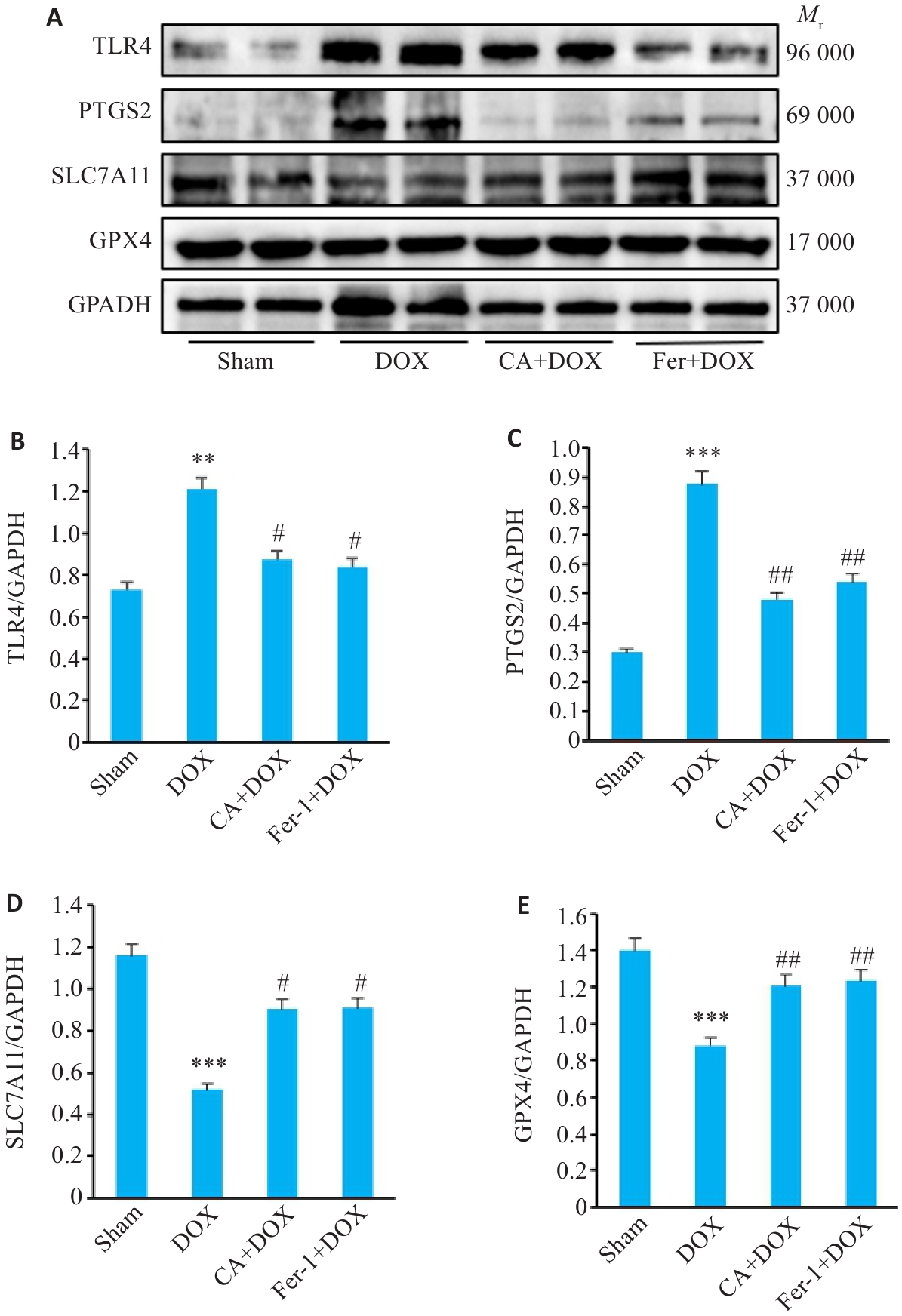
Fig.11 Comparison of TLR4, PTGS2, SLC7A11 and GPX4 protein expressions in the myocardial tissues among the 4 groups. A: Protein bands in Western blotting. B-E: Relative protein levels of TLR4, PTGS2, SLC7A11 and GPX4 proteins (Mean±SD, n=3). **P<0.01, ***P<0.001 vs the Sham group; #P<0.05, ##P<0.01 vs the DOX group.

Fig.12 Western blotting for detection of si-TLR4 transfection efficiency. A: Protein bands in Western blotting. B: Relative protein levels of TLR4 protein (Mean±SD, n=3). **P<0.01 vs the NC group.
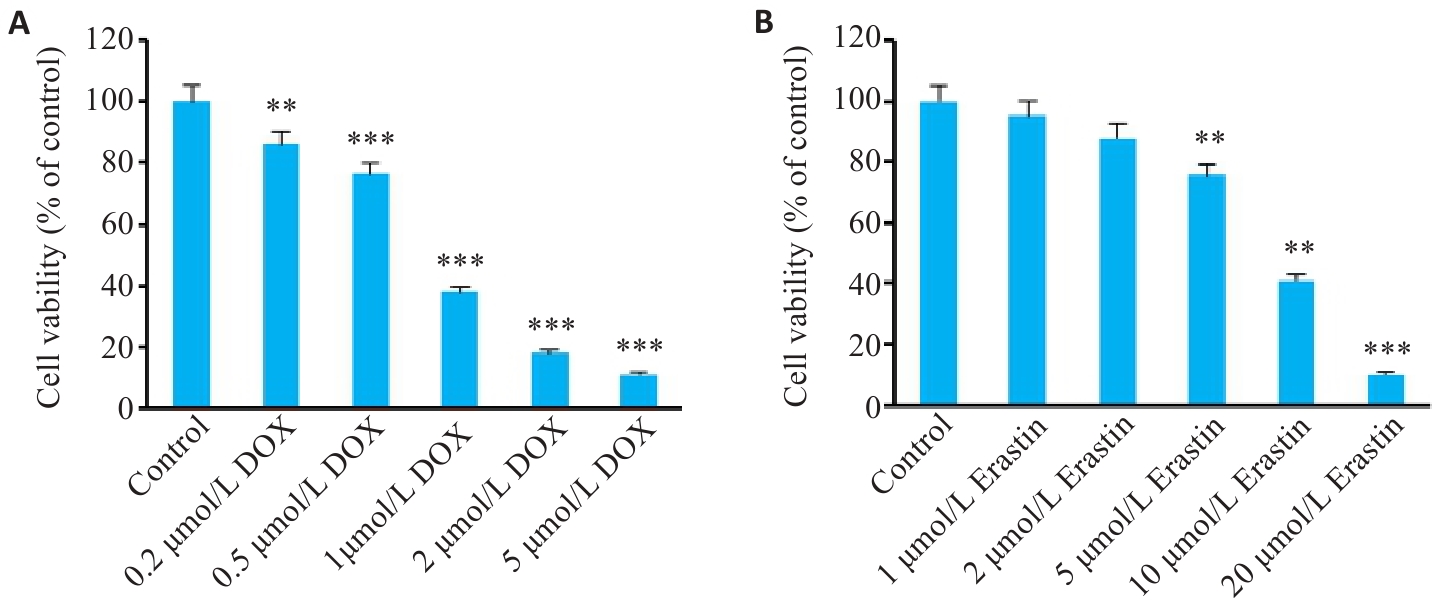
Fig.13 Viability of HL-1 cells treated with different concentrations of DOX (A) and Erastin (B). Data are presented as Mean±SD (n=6). **P<0.01, ***P<0.001 vs the NC group.
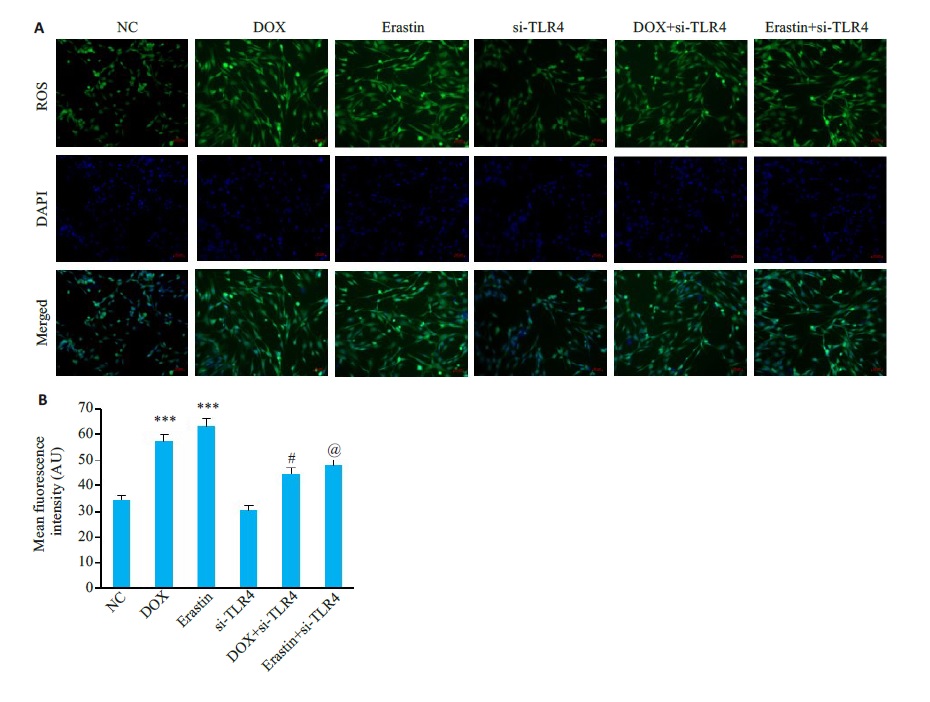
Fig.14 ROS levels in HL-1 cardiomyocytes in each group. A:DCFH-DA staining of HL-1 of the cells (×200). B: Meanfluorescence intensity levels (Mean±SD, n=6) ***P<0.001 vs the NC group; #P<0.05 vs the DOX group; @<0.05 vs the Erastin group.
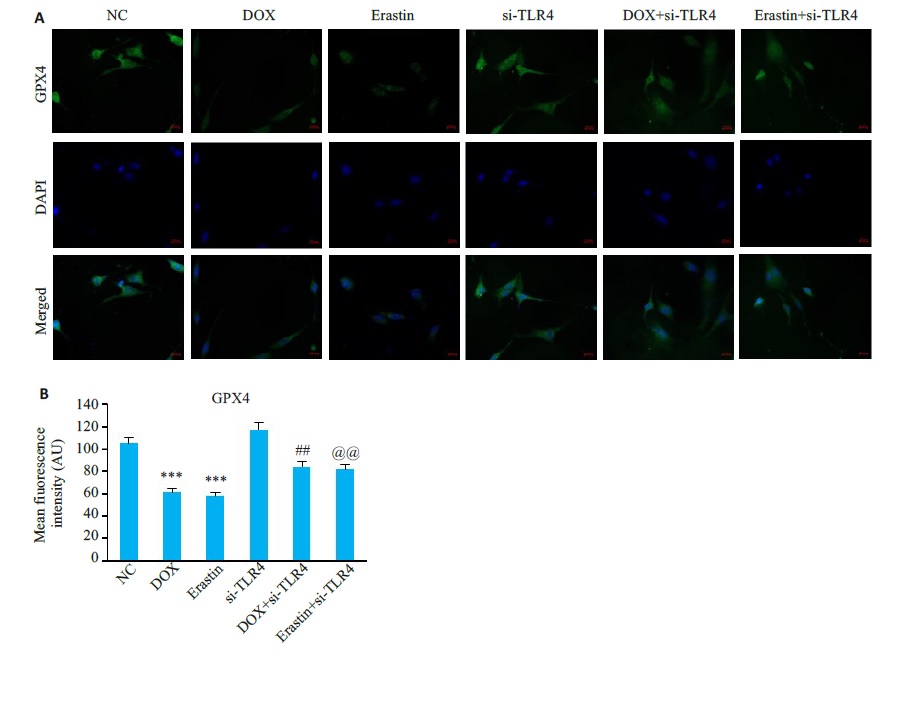
Fig.15 Immunofluorescence staining for GPX4 in HL-1cells in each group. A: Representative images ofimmunofluorescence staining of HL-1 cells in each group(×400). B: GPX4 fluorescence intensity in each group (Mean±SD,n=6). ***P<0.001vsP<0.01 vsthe NC group; ##P<0.01 vs the DOX group; @@P<0.01 vs the Erastin group.
| [1] | Sohail M, Sun Z, Li Y, et al. Research progress in strategies to improve the efficacy and safety of doxorubicin for cancer chemotherapy[J]. Expert Rev Anticancer Ther, 2021, 21(12): 1385-98. doi:10.1080/14737140.2021.1991316 |
| [2] | Prasanna PL, Renu K, Valsala Gopalakrishnan A. New molecular and biochemical insights of doxorubicin-induced hepatotoxicity[J]. Life Sci, 2020, 250: 117599. doi:10.1016/j.lfs.2020.117599 |
| [3] | Dixon SJ, Lemberg KM, Lamprecht MR, et al. Ferroptosis: an iron-dependent form of nonapoptotic cell death[J]. Cell, 2012, 149(5): 1060-72. doi:10.1016/j.cell.2012.03.042 |
| [4] | Cheng YF, Zak O, Aisen P, et al. Structure of the human transferrin receptor-transferrin complex[J]. Cell, 2004, 116(4): 565-76. doi:10.1016/s0092-8674(04)00130-8 |
| [5] | Yu H, Yang C, Jian L, et al. Sulfasalazine-induced ferroptosis in breast cancer cells is reduced by the inhibitory effect of estrogen receptor on the transferrin receptor[J]. Oncol Rep, 2019, 42(2): 826-38. |
| [6] | Teschke R. Treatment of drug-induced liver injury[J]. Biomedicines, 2022, 11(1): 15. doi:10.3390/biomedicines11010015 |
| [7] | Pontiki E, Hadjipavlou-Litina D. Multi-target cinnamic acids for oxidative stress and inflammation: design, synthesis, biological evaluation and modeling studies[J]. Molecules, 2018, 24(1): E12. doi:10.3390/molecules24010012 |
| [8] | Song F, Li H, Sun JY, et al. Protective effects of cinnamic acid and cinnamic aldehyde on isoproterenol-induced acute myocardial ischemia in rats[J]. J Ethnopharmacol, 2013, 150(1): 125-30. doi:10.1016/j.jep.2013.08.019 |
| [9] | Sova M. Antioxidant and antimicrobial activities of cinnamic acid derivatives[J]. Mini Rev Med Chem, 2012, 12(8): 749-67. doi:10.2174/138955712801264792 |
| [10] | Takao K, Toda K, Saito T, et al. Synthesis of amide and ester derivatives of cinnamic acid and its analogs: evaluation of their free radical scavenging and monoamine oxidase and cholinesterase inhibitory activities[J]. Chem Pharm Bull: Tokyo, 2017, 65(11): 1020-7. doi:10.1248/cpb.c17-00416 |
| [11] | 王凤雪, 高 宇, 刘海波.中药网络药理学研究流程及代表性数据库工具[J].中国现代中药, 2021, 23(6): 1111-8. |
| [12] | Lu SM, Yang B, Tan ZB, et al. TaoHe ChengQi decoction ameliorates sepsis-induced cardiac dysfunction through anti-ferroptosis via the Nrf2 pathway[J]. Phytomedicine, 2024, 129: 155597. doi:10.1016/j.phymed.2024.155597 |
| [13] | Volkova M, Russell R. Anthracycline cardiotoxicity: prevalence, pathogenesis and treatment[J]. Curr Cardiol Rev, 2011, 7(4): 214-20. doi:10.2174/157340311799960645 |
| [14] | Tacar O, Sriamornsak P, Dass CR. Doxorubicin: an update on anticancer molecular action, toxicity and novel drug delivery systems[J]. J Pharm Pharmacol, 2013, 65(2): 157-70. doi:10.1111/j.2042-7158.2012.01567.x |
| [15] | Wang L, Chen Q, Qi H, et al. Doxorubicin-induced systemic inflammation is driven by upregulation of toll-like receptor TLR4 and endotoxin leakage[J]. Cancer Res, 2016, 76(22): 6631-42. doi:10.1158/0008-5472.can-15-3034 |
| [16] | Singla DK, Johnson TA, Tavakoli Dargani Z. Exosome treatment enhances anti-inflammatory M2 macrophages and reduces inflammation-induced pyroptosis in doxorubicin-induced cardiomyopathy[J]. Cells, 2019, 8(10): E1224. doi:10.3390/cells8101224 |
| [17] | Lan Y, Wang Y, Huang K, et al. Heat shock protein 22 attenuates doxorubicin-induced cardiotoxicity via regulating inflammation and apoptosis[J]. Front Pharmacol, 2020, 11: 257. doi:10.3389/fphar.2020.00257 |
| [18] | Hu S, Liu B, Yang M, et al. Carnosic acid protects against doxorubicin-induced cardiotoxicity through enhancing the Nrf2/HO-1 pathway[J]. Food Funct, 2023, 14(8): 3849-62. doi:10.1039/d2fo03904d |
| [19] | Tadokoro T, Ikeda M, Ide T, et al. Mitochondria-dependent ferroptosis plays a pivotal role in doxorubicin cardiotoxicity[J]. JCI Insight, 2020, 5(9): 132747. doi:10.1172/jci.insight.132747 |
| [20] | Fang X, Wang H, Han D, et al. Ferroptosis as a target for protection against cardiomyopathy[J]. Proc Natl Acad Sci USA, 2019, 116(7): 2672-80. doi:10.1073/pnas.1821022116 |
| [21] | Xu F, Wang F, Wen T, et al. Protective effect of cinnamic acid in endotoxin-poisoned mice[J]. Phytother Res, 2017, 31(12): 1946-53. doi:10.1002/ptr.5944 |
| [22] | Koczurkiewicz-Adamczyk P, Klaś K, Gunia-Krzyżak A, et al. Cinnamic acid derivatives as cardioprotective agents against oxidative and structural damage induced by doxorubicin[J]. Int J Mol Sci, 2021, 22(12): 6217. doi:10.3390/ijms22126217 |
| [23] | 庄延双, 蔡宝昌, 张自力. 网络药理学在中药研究中的应用进展[J]. 南京中医药大学学报, 2021, 37(1): 156-60. |
| [24] | 杜若丽, 云 琦, 王奕人, 等.白花丹素通过抑制JAK2/STAT3通路减弱焦亡对抗脓毒症心肌损伤[J].南方医科大学学报,2024,44(11):2209-19. |
| [25] | Oo TT, Sumneang N, Ongnok B, et al. L6H21 protects against cognitive impairment and brain pathologies via toll-like receptor 4-myeloid differentiation factor 2 signalling in prediabetic rats[J]. Br J Pharmacol, 2022, 179(6): 1220-36. doi:10.1111/bph.15741 |
| [26] | Alanazi AM, Fadda L, Alhusaini A, et al. Liposomal resveratrol and/or carvedilol attenuate doxorubicin-induced cardiotoxicity by modulating inflammation, oxidative stress and S100A1 in rats[J]. Antioxidants: Basel, 2020, 9(2): E159. doi:10.3390/antiox9020159 |
| [27] | Li B, Cai XY, Wang YX, et al. Circ-SKA3 enhances doxorubicin toxicity in AC16 cells through miR-1303/TLR4 axis[J]. Int Heart J, 2021, 62(5): 1112-23. doi:10.1536/ihj.20-809 |
| [28] | Xu L, Wang C, Zou Z, et al. Ozone attenuated H9c2 cell injury induced by doxorubicin[J]. J Cardiovasc Pharmacol, 2021, 78(1): e86-93. doi:10.1097/fjc.0000000000001043 |
| [29] | Feng PP, Yang Y, Liu N, et al. Baicalin regulates TLR4/IκBα/NFκB signaling pathway to alleviate inflammation in Doxorubicin related cardiotoxicity[J]. Biochem Biophys Res Commun, 2022, 637: 1-8. doi:10.1016/j.bbrc.2022.10.061 |
| [30] | Riad A, Bien S, Gratz M, et al. Toll-like receptor-4 deficiency attenuates doxorubicin-induced cardiomyopathy in mice[J]. Eur J Heart Fail, 2008, 10(3): 233-43. doi:10.1016/j.ejheart.2008.01.004 |
| [31] | Li YC, Huang LT, Li JL, et al. Targeting TLR4 and regulating the Keap1/Nrf2 pathway with andrographolide to suppress inflamm-ation and ferroptosis in LPS-induced acute lung injury[J]. Chin J Nat Med, 2024, 22(10): 914-28. doi:10.1016/s1875-5364(24)60727-2 |
| [32] | Chen D, Geng Y, Deng Z, et al. Inhibition of TLR4 alleviates heat stroke-induced cardiomyocyte injury by down-regulating inflamm-ation and ferroptosis[J]. Molecules, 2023, 28(5): 2297. doi:10.3390/molecules28052297 |
| [1] | Qin HU, Hua JIN. Qingshen Granules improves renal function of patients with chronic kidney disease damp-heat syndrome by activating the miR-23b and Nrf2 pathway [J]. Journal of Southern Medical University, 2025, 45(9): 1867-1879. |
| [2] | Ziwei YANG, Chang LÜ, Zhu DONG, Shulei JI, Shenghui BI, Xuehua ZHANG, Xiaowu WANG. Rosa laevigata Michx. inhibits pulmonary arterial smooth muscle cell proliferation in hypertension by modulating the Src-AKT1 axis [J]. Journal of Southern Medical University, 2025, 45(9): 1889-1902. |
| [3] | Rongmao HE, Zeyang FANG, Yunyun ZHANG, Youliang WU, Shixiu LIANG, Tao JI, Kequan CHEN, Siqi WANG. Diagnostic and predictive value of ferroptosis-related genes in patients with ulcerative colitis [J]. Journal of Southern Medical University, 2025, 45(9): 1927-1937. |
| [4] | Zejin OU, Ying LI, Shi CHEN, Ziyi WANG, Meiyi HE, Zhicheng CHEN, Shihao TANG, Xiaojing MENG, Zhi WANG. Inhibition of ferroptosis alleviates acute kidney injury caused by diquat in zebrafish [J]. Journal of Southern Medical University, 2025, 45(8): 1743-1750. |
| [5] | Junyi LI, Siyuan CHEN, Liyao XIE, Jin WANG, Ao CHENG, Shaowei ZHANG, Jiyu LIN, Zhihan FANG, Yirui PAN, Chonghe CUI, Gengxin CHEN, Chao ZHANG, Li LI. β-sitosterol, an important component in the fruits of Alpinia oxyphylla Miq., prolongs lifespan of Caenorhabditis elegans by suppressing the ferroptosis pathway [J]. Journal of Southern Medical University, 2025, 45(8): 1751-1757. |
| [6] | Xinyuan CHEN, Chengting WU, Ruidi LI, Xueqin PAN, Yaodan ZHANG, Junyu TAO, Caizhi LIN. Shuangshu Decoction inhibits growth of gastric cancer cell xenografts by promoting cell ferroptosis via the P53/SLC7A11/GPX4 axis [J]. Journal of Southern Medical University, 2025, 45(7): 1363-1371. |
| [7] | Liming WANG, Hongrui CHEN, Yan DU, Peng ZHAO, Yujie WANG, Yange TIAN, Xinguang LIU, Jiansheng LI. Yiqi Zishen Formula ameliorates inflammation in mice with chronic obstructive pulmonary disease by inhibiting the PI3K/Akt/NF-κB signaling pathway [J]. Journal of Southern Medical University, 2025, 45(7): 1409-1422. |
| [8] | Yinfu ZHU, Yiran LI, Yi WANG, Yinger HUANG, Kunxiang GONG, Wenbo HAO, Lingling SUN. Therapeutic mechanism of hederagenin, an active component in Guizhi Fuling Pellets, against cervical cancer in nude mice [J]. Journal of Southern Medical University, 2025, 45(7): 1423-1433. |
| [9] | Mengying ZHANG, Chenling ZHAO, Liwei TIAN, Guofang YU, Wenming YANG, Ting DONG. Gandou Fumu Decoction improves liver steatosis by inhibiting hepatocyte ferroptosis in mice with Wilson's disease through the GPX4/ACSL4/ALOX15 signaling pathway [J]. Journal of Southern Medical University, 2025, 45(7): 1471-1478. |
| [10] | Lijun HE, Xiaofei CHEN, Chenxin YAN, Lin SHI. Inhibitory effect of Fuzheng Huaji Decoction against non-small cell lung cancer cells in vitro and the possible molecular mechanism [J]. Journal of Southern Medical University, 2025, 45(6): 1143-1152. |
| [11] | Guoyong LI, Renling LI, Yiting LIU, Hongxia KE, Jing LI, Xinhua WANG. Therapeutic mechanism of Arctium lappa extract for post-viral pneumonia pulmonary fibrosis: a metabolomics, network pharmacology analysis and experimental verification [J]. Journal of Southern Medical University, 2025, 45(6): 1185-1199. |
| [12] | Liping GUAN, Yan YAN, Xinyi LU, Zhifeng LI, Hui GAO, Dong CAO, Chenxi HOU, Jingyu ZENG, Xinyi LI, Yang ZHAO, Junjie WANG, Huilong FANG. Compound Centella asiatica formula alleviates Schistosoma japonicum-induced liver fibrosis in mice by inhibiting the inflammation-fibrosis cascade via regulating the TLR4/MyD88 pathway [J]. Journal of Southern Medical University, 2025, 45(6): 1307-1316. |
| [13] | Anbang ZHANG, Xiuqi SUN, Bo PANG, Yuanhua WU, Jingyu SHI, Ning ZHANG, Tao YE. Electroacupuncture pretreatment alleviates cerebral ischemia-reperfusion injury in rats by inhibiting ferroptosis through the gut-brain axis and the Nrf2/HO-1 signaling pathway [J]. Journal of Southern Medical University, 2025, 45(5): 911-920. |
| [14] | Peipei TANG, Yong TAN, Yanyun YIN, Xiaowei NIE, Jingyu HUANG, Wenting ZUO, Yuling LI. Tiaozhou Ziyin recipe for treatment of premature ovarian insufficiency: efficacy, safety and mechanism [J]. Journal of Southern Medical University, 2025, 45(5): 929-941. |
| [15] | Xiaotao LIANG, Yifan XIONG, Xueqi LIU, Xiaoshan LIANG, Xiaoyu ZHU, Wei XIE. Huoxue Shufeng Granule alleviates central sensitization in chronic migraine mice via TLR4/NF-κB inflammatory pathway [J]. Journal of Southern Medical University, 2025, 45(5): 986-994. |
| Viewed | ||||||
|
Full text |
|
|||||
|
Abstract |
|
|||||